HANGZHOU, CHINA / ACCESS Newswire / July 11, 2025 / In the era of rapid technological advancement, smart robots, as the epitome of cutting-edge technologies, have demonstrated explosive growth. Data shows that the global smart robot market size surged from 158.3 billion yuan in 2020 to 369 billion yuan in 2024, with a compound annual growth rate (CAGR) as high as 23.6%.
In this wave, "Embodied Intelligence" robots are becoming a key direction for technological breakthroughs. Different from traditional robots, embodied intelligence robots realize the ability of intelligent interaction with the physical environment through a closed-loop system of "perception-decision-action".
Within this technical framework, robot forms have evolved into three mainstream directions: tracked (high-load stable movement), wheeled (high-efficiency planar motion), and legged (complex terrain adaptation, including humanoid). Among them, quadruped robots, by virtue of balancing motion stability and terrain adaptability, have become one of the most promising carriers for Embodied Intelligence in terms of industrialization.
In China's quadruped robot sector, DEEP Robotics has established a leading edge with its Jueying (Absolute Shadow) series of products. These products have demonstrated excellent adaptability in complex scenarios such as power inspection, emergency rescue, and police security. They have been widely applied in multiple key domestic industry fields and successfully entered overseas markets, with implementations in international projects like Singapore's national power grid.
It is worth noting that in complex and ever-changing practical application scenarios, traditional robots often face the dilemma of being unable to balance efficiency and adaptability. To breakthis limitation, DEEP Robotics has innovatively launched the "wheel-foot robot" - LYNX M20, which can achieve wheeled high-speed movement on flat roads and switch to foot-type obstacle-crossing mode on complex terrain.
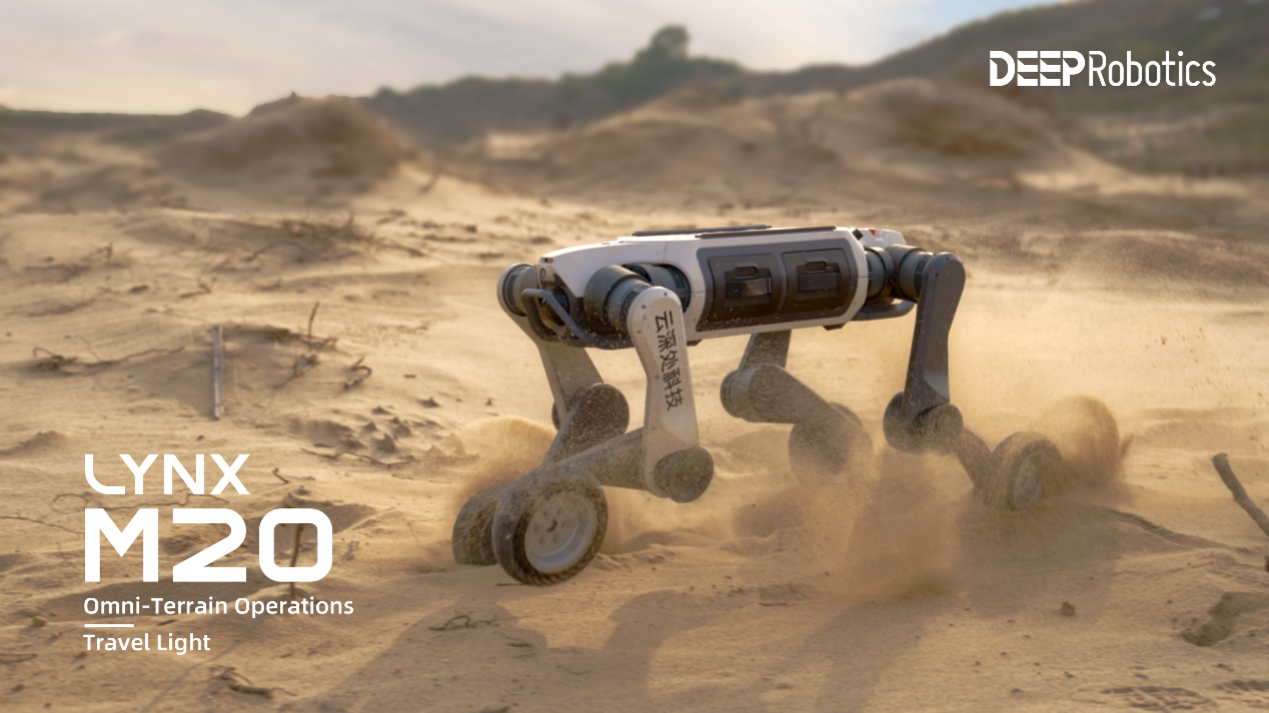
According to official data, this product is "the world's first industry-applied wheel-foot robot specially built for complex terrains and dangerous environments". LYNX M20 can handle complex terrains such as deserts, snowfields, swamps, and mountains, and boasts industrial-grade performance including IP66 protection, 2.5-hour battery life, and 15kg load capacity. This evaluation will verify whether it deserves the title of "King of All-domain Operations" from four major dimensions: movement capability, environmental adaptability, functional expansion, and actual combat performance.
1.Product highlights
Excellent flexibility
LYNX M20 weighs only 33kg and can be carried by a single person. Compared with other robots of the same type, it has a more compact size, making it convenient for operators to carry and transport in certain specific scenarios.
It features seamless "morphing" capability between two forms, with an ultra-large joint movement range and the ability to seamlessly switch between double-leg configurations. The "front elbow and rear knee" structure allows LYNX M20 to easily navigate through narrow dead corners, Moreover, it features omnidirectional movement, allowing it to make zero-radius turns in tight spaces without needing to change orientation. , freely pass through narrow channels only 50cm wide, and penetrate into confined spaces such as tunnels and pipe corridors. In specific scenarios, it can also seamlessly switch to the "full elbow mode", demonstrating excellent obstacle-crossing ability in complex situations.
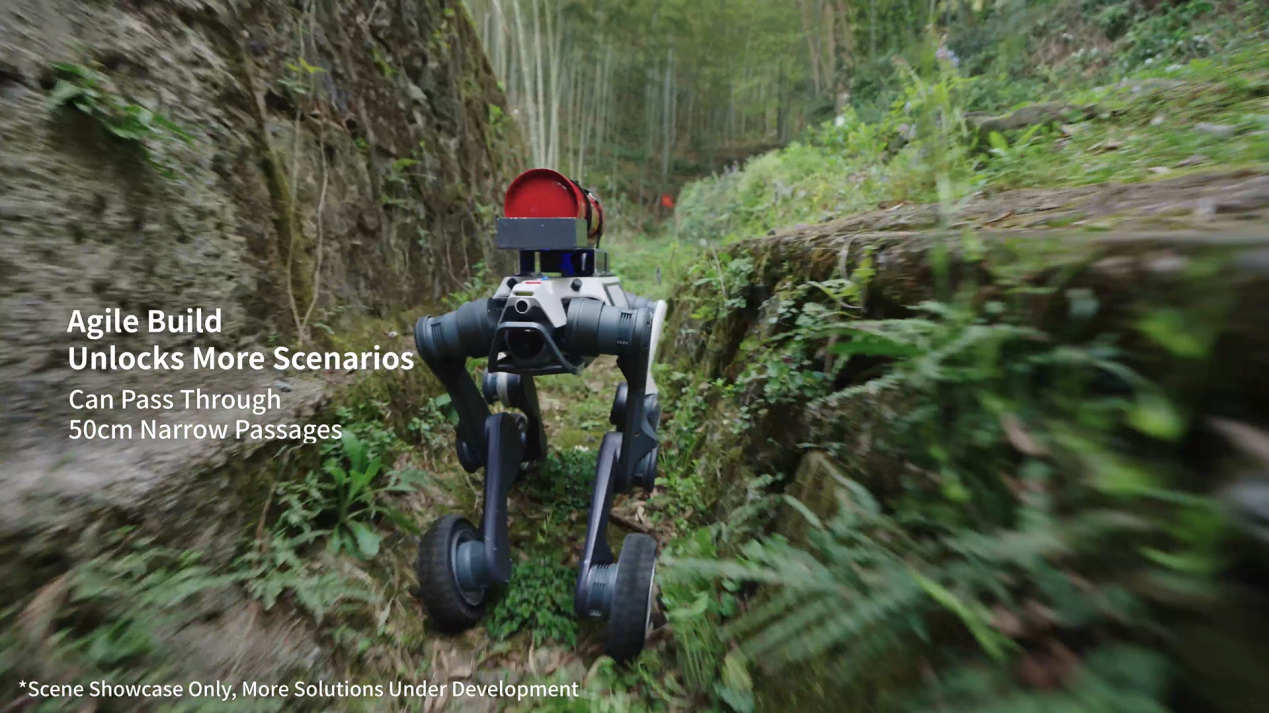
Compared with Spot's self-weight of 32.7kg, LYNX M20 has more advantages in the comprehensive performance of flexibility and portability. When operating in complex spaces, it can respond to task requirements at a faster speed and improve overall work efficiency.

In addition, apart from the lightweight design specifically created for certain scenarios and operations, as an industrial-grade wheel-foot robot designed for operations on complex terrains, LYNX M20 boasts excellent terrain-conquering capabilities. Its unique wheel-foot integrated structure enables it to climb slopes with an extreme gradient of 45°, and the maximum vertical obstacle-crossing height reaches 80 centimeters, which allows LYNX M20 to exhibit extremely strong adaptive terrain capabilities in operation scenarios such as emergency rescue.
Strong functional expansibility
LYNX M20 is equipped with a variety of interfaces on its back, including 24V/72V power interfaces, Gigabit Ethernet ports, and USB 3.0 interfaces etc. This provides a broad space for its functional expansion, allowing users to conveniently and quickly install various professional devices according to different operational needs.
Take power inspection as an example: a dual-light pan-tilt can be installed, and through the collaboration of visible light and thermal imaging, comprehensive and accurate monitoring of transmission lines can be achieved; In fire emergency scenarios, mounting fire-extinguishing devices and life detectors enables it to go deep into dangerous areas to carry out rescue work.

In terms of secondary development capabilities, LYNX M20 provides industry users with richer business-side development interfaces (such as standardized mechanical/electrical interfaces, Gigabit Ethernet ports, and USB3.0), which can quickly adapt to professional modules such as power inspection equipment and sensor kits, significantly improving the efficiency of secondary development. GO2 W mainly focuses on functions such as basic movement and intelligent OTA upgrades, with a load capacity of about 8kg (maximum ~12kg), making it difficult to carry large or various types of professional equipment like LYNX M20, and thus unable to meet some industrial-grade application scenarios with high requirements for functional diversity.
Good endurance and durability
LYNX M20 can achieve an effective payload endurance of 2.5 hours with a maximum cruising range of 12km, and it supports hot-swappable battery replacement, allowing for quick battery changes without stopping operations during work, thus enabling long-term continuous operation. In contrast, Spot can run for 90 minutes on a single charge, with endurance far inferior to that of LYNX M20.
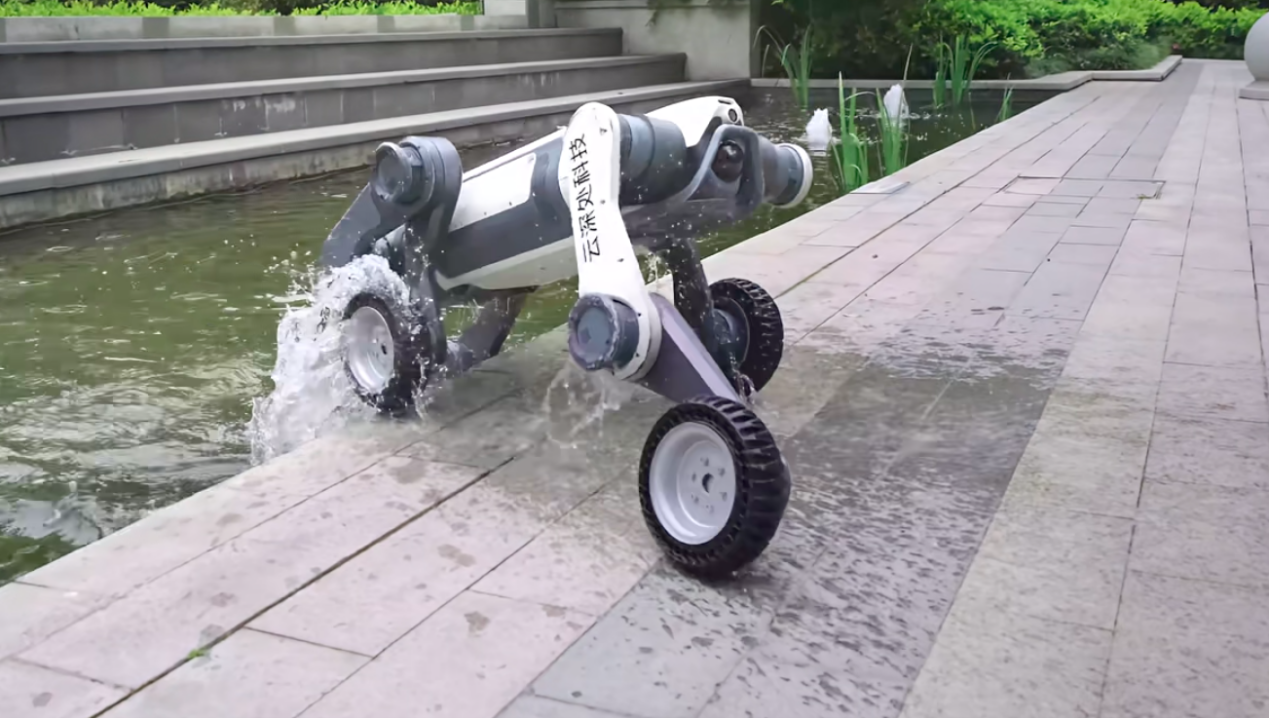
In terms of protection level, LYNX M20 reaches IP66 (Note: IP66 protection level means the product is completely protected against the intrusion of external objects and can completely prevent dust from entering; when subjected to violent wave impact or strong water spray, the amount of water entering the machine should not reach a harmful level). It is completely dustproof, can resist strong water impact, can work normally in extreme temperature environments ranging from -20? to 55?, and is also equipped with a night fill light device, enabling it to adapt to dark environments. Spot has a protection level of IP54, which can only prevent dust intrusion and limited water splashing, so its adaptability in harsh environments is not as good as that of LYNX M20. LYNX M20 has stronger durability and can work more stably in complex and harsh environments.
Excellent environmental perception
LYNX M20 is equipped with a 96-line LiDAR, which can generate high-quality point clouds at approximately 860,000 points per second. It features an ultra-large field of view of 360°×90°, supports positioning, mapping, navigation, and omnidirectional obstacle avoidance, and is also equipped with a 360° point cloud surround view function.
GO2 W is equipped with a 4D LiDAR L1, with the same field of view of 360°×90° (minimum detection distance of 0.05 meters), but the point cloud output is approximately 43,000 points per meter (calculated based on the parameters of Unitree 4D LiDAR L1). The high-density point cloud of LYNX M20 has more advantages in capturing obstacle details, making it especially suitable for complex scenarios that require precise obstacle avoidance.
Spot adopts a solution of four sets of depth cameras + 3D distance sensors to achieve 360° visual perception, but is not equipped with a high-line-beam LiDAR. Relatively speaking, the LiDAR of LYNX M20 performs better in distance measurement accuracy and ambient light stability, especially in dark or strong light environments.
2. Actual combat scene evaluation
Desert steep slope sprint: The official video of DEEP Robotics starts with a scene showing LYNX M20 sprinting on a desert steep slope. The desert geology is soft with low friction, making it difficult for ordinary legged and wheeled robots to maintain their balance. However, LYNX M20 can ensure stable movement on the desert ground through the combination of wheeled foot soles and legged movement gaits, effectively coping with complex terrains such as deserts.
Muddy marsh traversal: Footage from DEEP Robotics shows that when operating in muddy marsh areas, LYNX M20's legged drive system can automatically adjust its stride length according to the terrain. When its feet encounter obstacles hidden beneath the mud, the motion system responds quickly to adjust its movement posture to navigate over them. Even when its IP66-protected exterior is covered in mud, the device continues to function normally, demonstrating reliable performance in harsh environments.
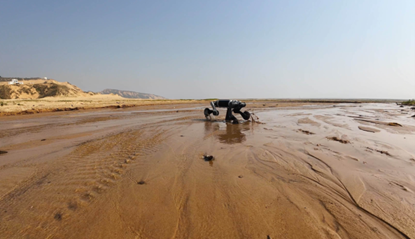
Ruins obstacle-crossing demonstration: In the video simulating a mountain forest fire scenario, LYNX M20 can switch to the "front elbow and rear knee" movement configuration to climb over obstacles. Besides, in narrow passages, M20 can also move freely thanks to its relatively compact size. With the wheel-foot form, it doesn't need to change direction, demonstrating speed and movement advantages in complex environments. The dual-module device mounted on the mechanical interface of the fuselage works synchronously - the dual-light pan-tilt marks the heat source of the fire point in real-time, and the fire-extinguishing equipment operates on the simulated fire source, showing the emergency response capability at the fire site.
Nighttime full-dark operation: In the full-darkness test at the end of the video, LYNX M20 can activate its supplementary lighting system, turning on both front and rear fill lights. Additionally, the device's 96-line LiDAR is capable of constructing a 3D environmental model even in complete darkness, assisting the robot dog in perceiving the surrounding environment.
Scenario application test
Mountain forest fire-fighting scenario: Although the official video does not elaborate on the complete process of mountain forest fire-fighting, judging from the performance of LYNX M20, it is capable of moving quickly in the complex terrain of mountain forests. It can carry fire-fighting equipment to go deep into the fire site, and cooperate with devices such as thermal imaging to conduct fire reconnaissance and preliminary disposal.
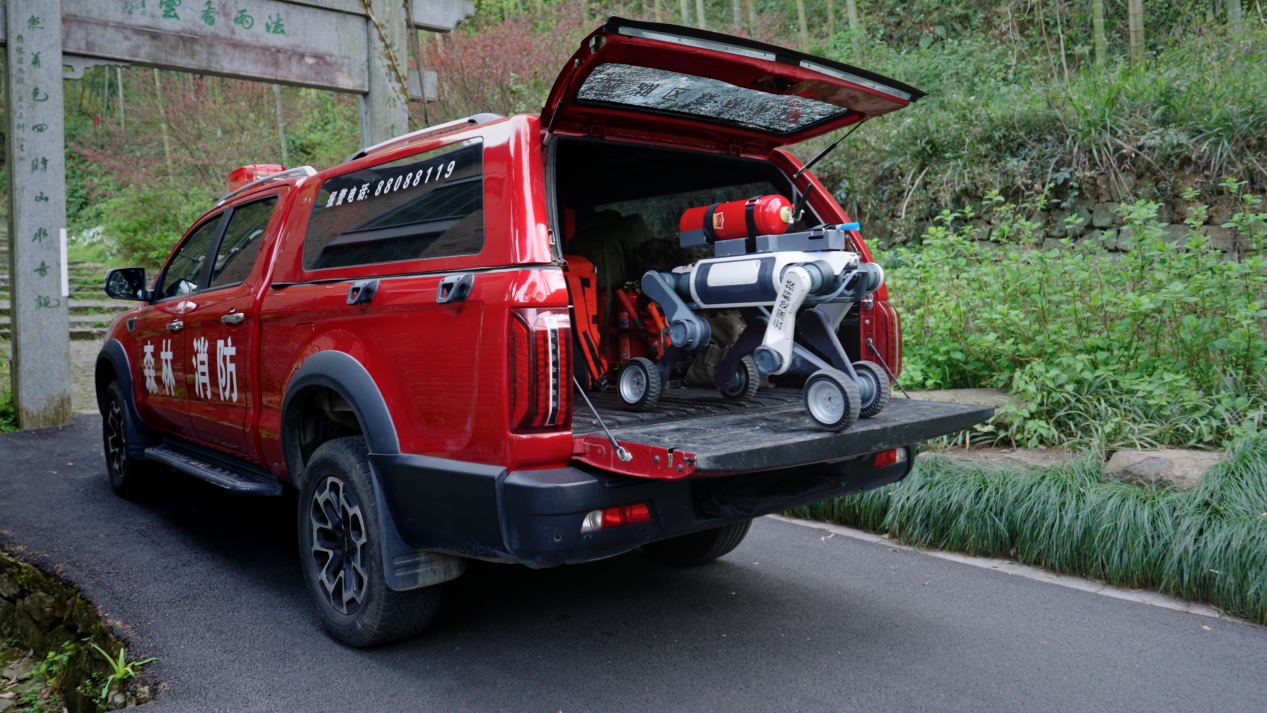
Power inspection application: Combining its product features, LYNX M20 can traverse complex terrains such as mountains and forests to conduct close-range inspections of transmission lines. The sensors and other equipment it carries can promptly detect potential hidden dangers in the lines, ensuring the safe operation of the power system.
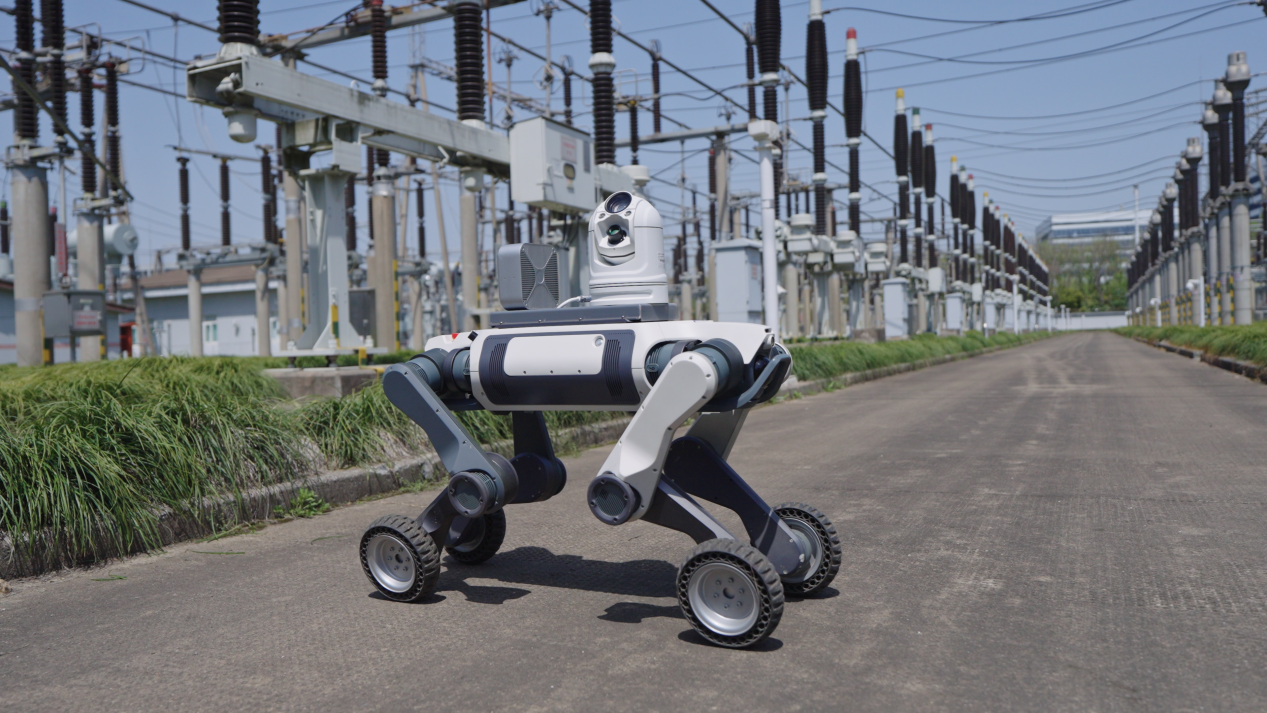
Logistics and distribution scenario: In terms of logistics and distribution, LYNX M20's load capacity and endurance make it capable of completing the last-mile delivery tasks in scenarios such as residential communities. It has more advantages compared with traditional distribution methods, especially in areas with complex terrain.
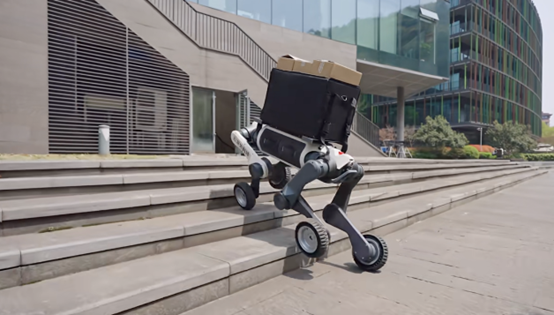
3.Comparison of similar products
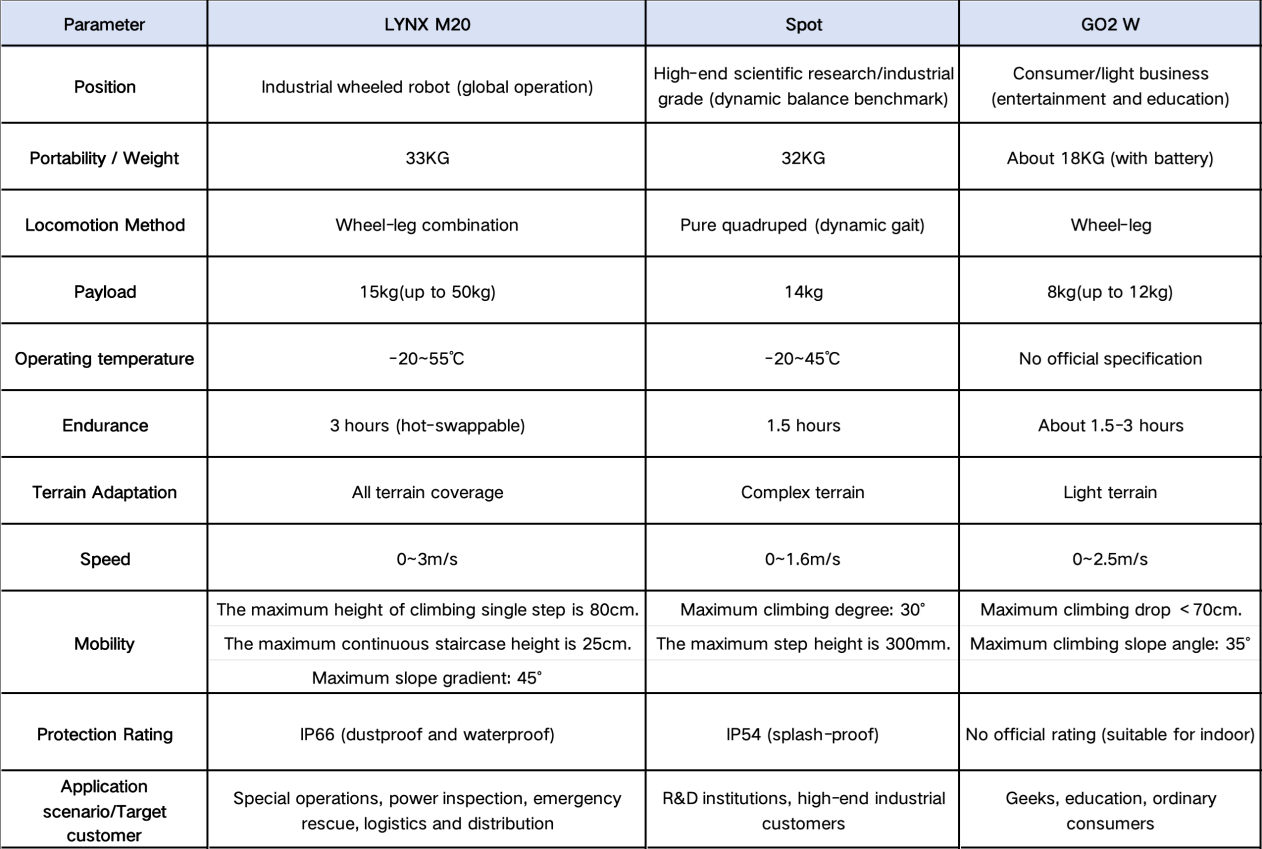
Comparison and summary:
GO2 W is an excellent consumer-grade product, but LYNX M20 holds significant advantages in professionalism, environmental adaptability, and functional expansion, making it suitable for industrial customers who truly require reliable operations. While Spot remains the pinnacle of motion control, LYNX M20, with its wheel-foot integration and industrial-grade cost-effectiveness, offers greater practical value in real operational scenarios.
4. Conclusion and prospect
Overall, as the world's first wheel-foot robot deeply customized for complex terrains and hazardous environments, DEEP Robotics' LYNX M20 has achieved a key breakthrough in the industrial robot field through its wheel-foot integrated design. It not only addresses the long-standing pain point of traditional robots-"the difficulty of balancing efficiency and adaptability"-but also demonstrates significant advantages in scenarios such as power inspection, emergency rescue, and logistics distribution with its modular ecosystem and industrial-grade reliability.
Compared with the consumer-grade GO2 W, LYNX M20 takes the lead in load capacity, environmental adaptability, and functional expandability. When compared to Spot, it achieves differentiated breakthroughs in industrial rigid demands such as endurance and protection, supported by a highly competitive cost advantage.
However, the popularization of LYNX M20 still faces certain challenges. Its customized development costs and high hardware investment brought by industry-grade high performance are relatively high, and large-scale mass production has not yet fully amortized the costs, but this does not prevent it from becoming a benchmark product in China's quadruped robot field at present. In the future, with the integration of technologies such as 5G remote control and AI autonomous decision-making, the application scenarios of LYNX M20 may be further expanded. It is worth looking forward to that with large-scale mass production and the maturity of the supply chain, the comprehensive application cost of LYNX M20 is expected to be further optimized, thus opening a broader market.
Company: DEEP Robotics
Contact: Vera Huang
Email 1: huanglingxiao@deeprobotics.cn
Email 2: partner@deeprobotics.cn
Inquiry Form: https://www.deeprobotics.cn/en/index/buy.html
SOURCE: DEEP Robotics
View the original press release on ACCESS Newswire:
https://www.accessnewswire.com/newsroom/en/computers-technology-and-internet/in-depth-evaluation-deep-robotics-lynx-m20-robot-dog-surpasses-th-1047854